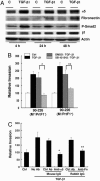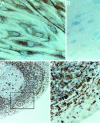Streptococcal modulation of cellular invasion via TGF-beta1 signaling
- PMID: 16467160
- PMCID: PMC1413688
- DOI: 10.1073/pnas.0506668103
Streptococcal modulation of cellular invasion via TGF-beta1 signaling
Abstract
Group A Streptococcus (GAS) and other bacterial pathogens are known to interact with integrins as an initial step in a complex pathway of bacterial ingestion by host cells. Efficient GAS invasion depends on the interaction of bound fibronectin (Fn) with integrins and activation of integrin signaling. TGF-beta1 regulates expression of integrins, Fn, and other extracellular matrix proteins, and positively controls the integrin signaling pathway. Therefore, we postulated that TGF-beta1 levels could influence streptococcal invasion of mammalian cells. Pretreatment of HEp-2 cells with TGF-beta1 increased their capacity to ingest GAS when the bacteria expressed fibronectin-binding proteins (M1 or PrtF1). Western blots revealed significant induction of alpha5 integrin and Fn expression by HEp-2 cells in response to TGF-beta1. Increased ingestion of streptococci by these cells was blocked by a specific inhibitor of the TGF-beta1 receptor I and antibodies directed against alpha5 integrin and Fn, indicating that increased invasion depends on TGF-beta1 up-regulation of both the alpha5 integrin and Fn. The capacity of TGF-beta1 to up-regulate integrin expression and intracellular invasion by GAS was reproduced in primary human tonsil fibroblasts, which could be a source of TGF-beta1 in chronically infected tonsils. The relationship between TGF-beta1 and GAS invasion was strengthened by the observation that TGF-beta1 production was stimulated in GAS-infected primary human tonsil fibroblasts. These findings suggest a mechanism by which GAS induce a cascade of changes in mammalian tissue leading to elevated expression of the alpha5beta1 receptor, enhanced invasion, and increased opportunity for survival and persistence in their human host.
Conflict of interest statement
Conflict of interest statement: No conflicts declared.
Figures








References
-
- Kaplan E. L., Johnson D. R. Pediatrics. 2001;108:1180–1186. - PubMed
-
- Gerber M. A., Tanz R. R., Kabat W., Bell G. L., Siddiqui B., Lerer T. J., Lepow M. L., Kaplan E. L., Shulman S. T. Pediatrics. 1999;104:911–917. - PubMed
-
- Osterlund A., Popa R., Nikkila T., Scheynius A., Engstrand L. Laryngoscope. 1997;107:640–647. - PubMed
-
- Park H. S., Francis K. P., Yu J., Cleary P. P. J. Immunol. 2003;171:2532–2537. - PubMed
-
- Bisno A. L., Brito M. O., Collins C. M. Lancet Infect. Dis. 2003;3:191–200. - PubMed
Publication types
MeSH terms
Substances
Grants and funding
LinkOut - more resources
Full Text Sources
Other Literature Sources
Medical
Miscellaneous

